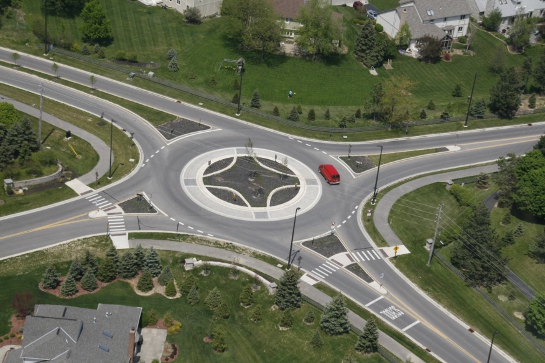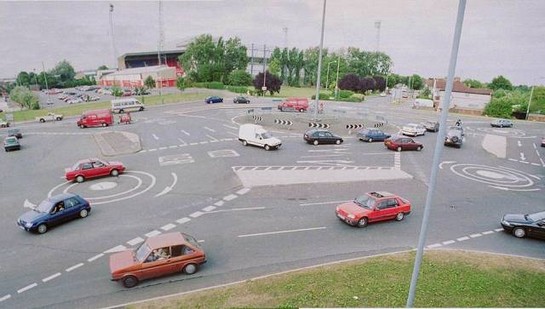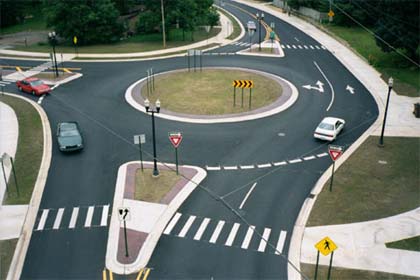
The roundabout is common across Europe though rarely seen in the USA. Properly designed, and used correctly, it can maintain traffic flow without the use of lights. Note that roundabouts rotate clockwise where you drive on the left and counter-clockwise in countries that drive on the right. Most, if not all, countries now follow the UK lead that traffic on the roundabout has priority over those entering it.
Remember it’s a ROUND about, so don’t square it off when going straight on by entering in the left lane, cutting across the right lane and leaving in the left lane – drivers turning right won’t expect you to cut across their line. Some drivers also become aggressive about such carelessness. Don’t do this even if the roundabout appears empty because there may be someone you’ve missed, like a motorcyclist, on your right.
Approach
On your approach to the roundabout, get into the correct lane for your intended exit as soon as you can, making full use of mirrors and signals as well as looking over your shoulder. This can be difficult for town roundabouts where signing may be late or inadequate and traffic heavy. Try to be aware of what others are doing around you and in very slow-moving traffic look out for those sneaking in where you least expect it.

On roundabouts with two approach lanes you normally use the left lane to turn left or go straight on and the right lane for exits beyond straight on. However, if the exit is a dual-carriageway it is acceptable to use the right lane if there is slower traffic on the left, though you must allow lorries extra turning space and keep a check on what vehicles to your left are doing: it may be someone intending to turn right who didn’t get in the right lane in time.
On three-lane entries the left lane is for left turns, though slow vehicles may use it for straight ahead, especially on dual-carriageways. The centre lane is for straight ahead only and the right lane for exits beyond straight ahead.
You do not have to stop at a roundabout if it is clear, but give yourself time to judge the speed and distance of anything on it and remember the danger of windscreen pillars hiding bikes and smaller vehicles coming round.
If you are second in the queue to join a roundabout, always keep an eye on the car in front. It is far too easy to get engrossed in traffic coming round the roundabout and to try to drive into a gap forgetting there is someone in front of you who may be slower to take advantage of the opportunity to move off. In the same way, don’t assume that because they have started to move off they will complete the exit: they could stall or stop because they feel they have misjudged the speed or position of oncoming vehicles. Most rear end shunts on roundabouts happen in one of these ways.

There was a time when road planners thought the way to increase traffic flow through roundabouts was to increase the width of the road around them; they now realize that this makes it harder for drivers to judge when it is safe to enter it. This is because oncoming cars towards the centre of the roundabout appear further away and in terms of the roundabout’s radius, they are. Unfortunately, the distance , that matters is how far away from you they are in terms of the roundabout’s circumference, because that determines how quickly they close on you. So take special care on wide roundabouts: take a good look at vehicles approaching you as you enter and beware of drivers entering unwisely as you go round.









